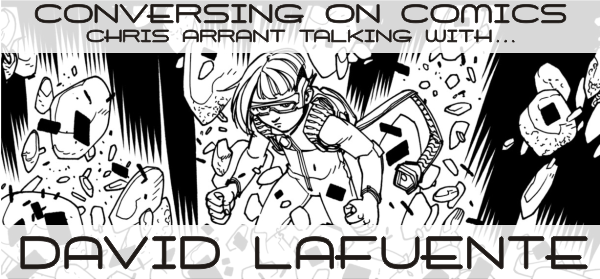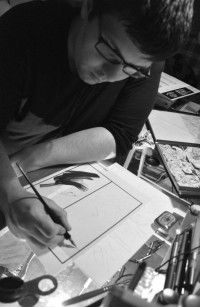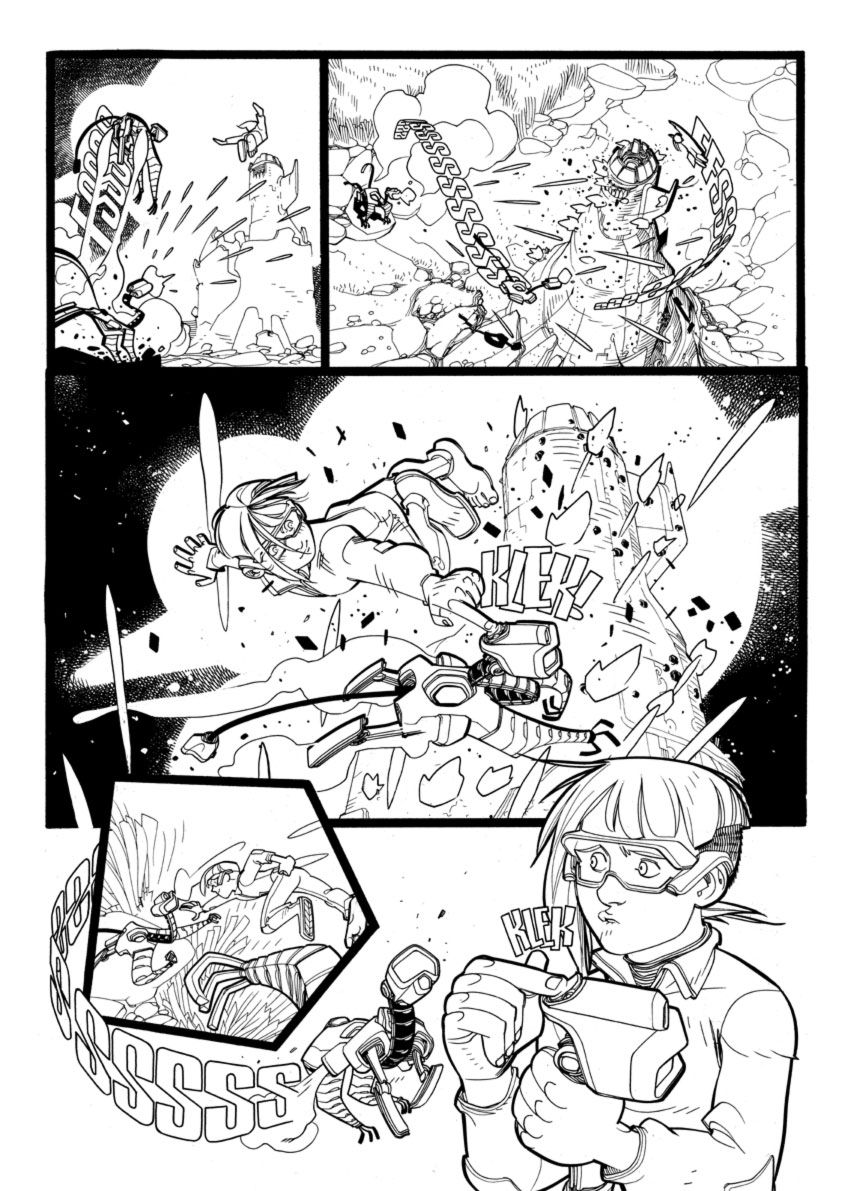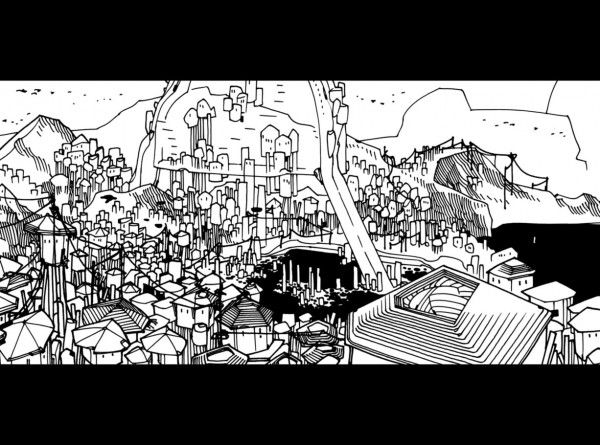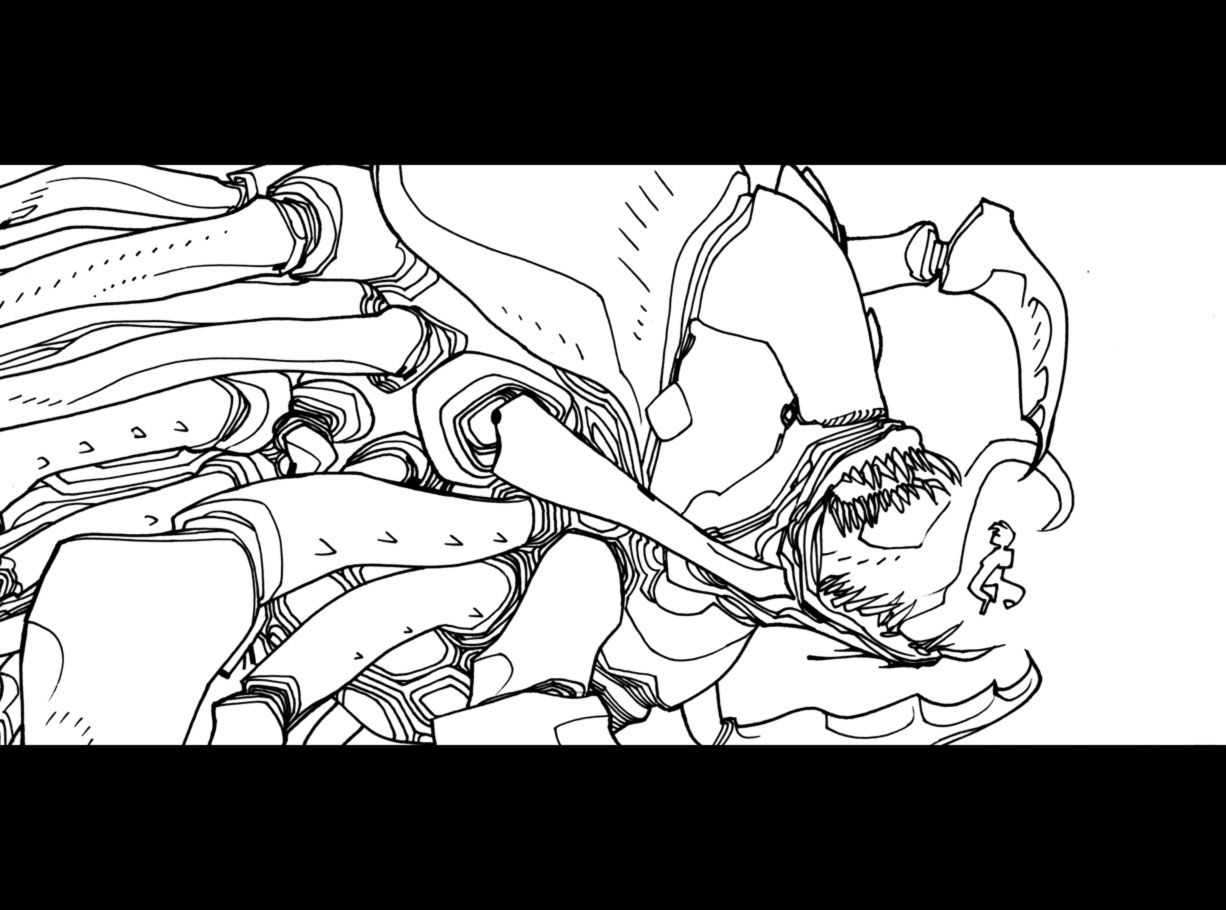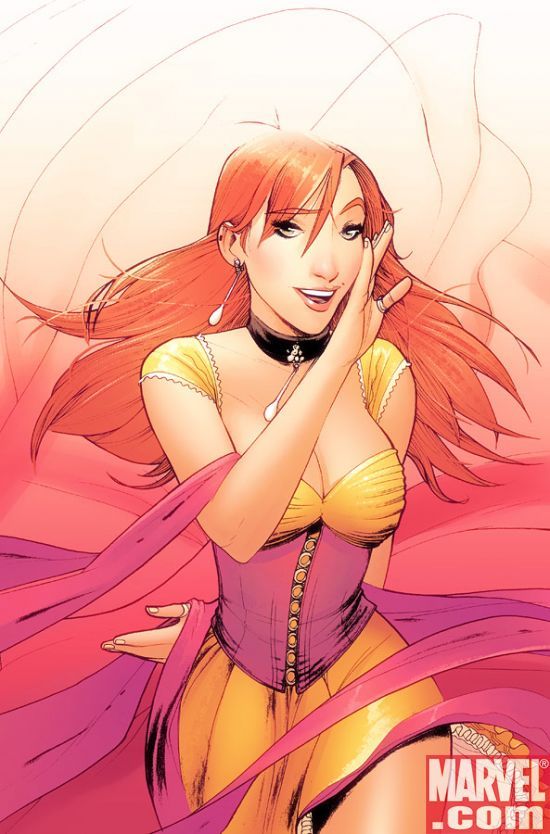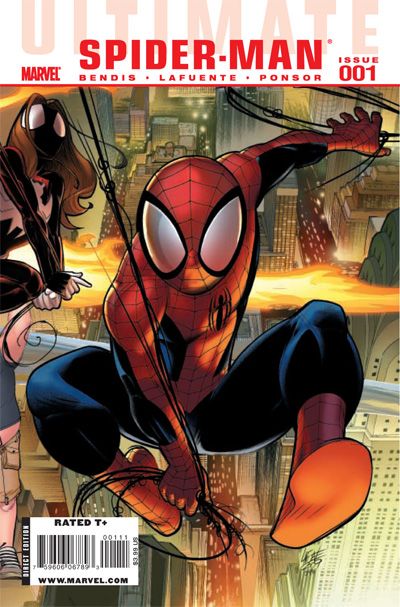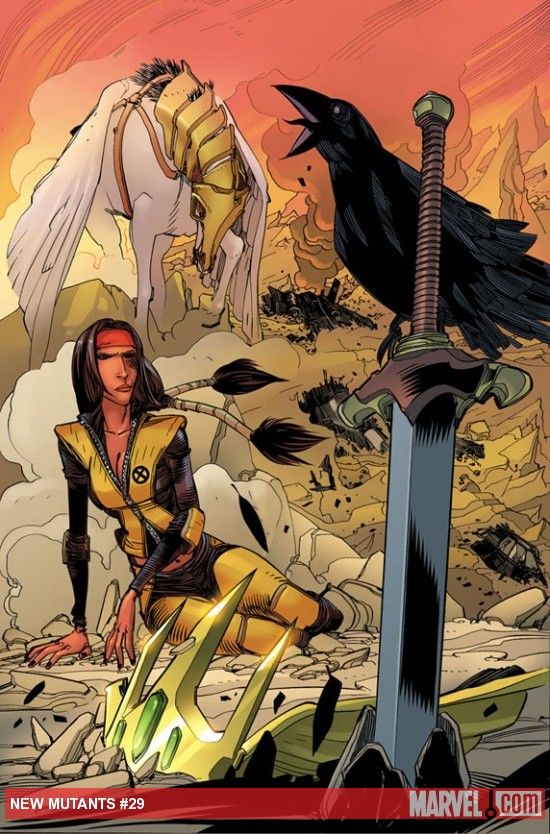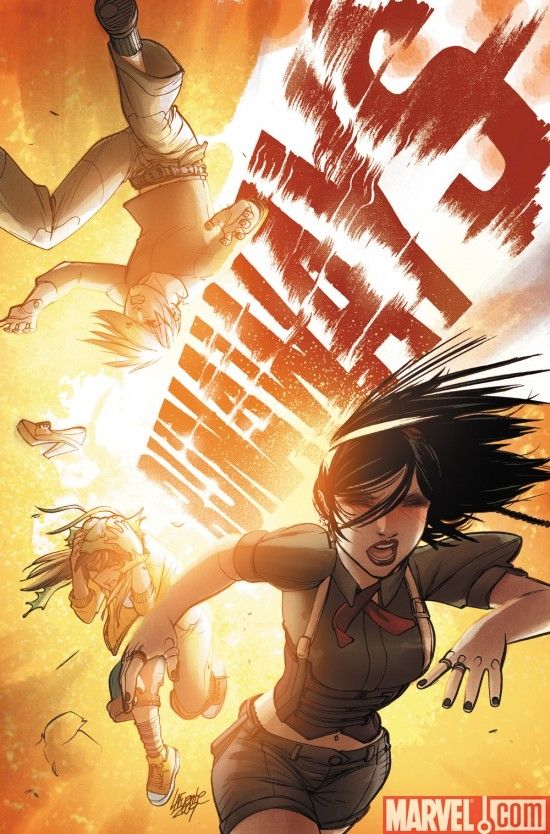Note: Due to some unforeseen transcription issues, the Steve Rude interview promised for this week won't be published until next Friday.
Spanish artist David Lafuente is one of those creators who burst into the American comics scene like a shooting star, first glimmering with 2008's Patsy Walker: Hellcat and then shining with blinding amount talent in 2009's Ultimate Comics Spider-Man. After his run on that title ended in late 2010, Lafuente followed that with covers for various Marvel series and a brief run on a group of characters close to his heart, the New Mutants. Since then, new work released by this artist has primarily been online on his blog and his recently ended art blog group the Sindiecate. What has he been working on in this down time? Creator-owned comics.
When I reached out to Lafuente to do this interview, I hoped to find out more about his upcoming series Home Run with Jonathan Ross, but what I ended up with was that -- and a whole lot more.
In what ended up being David's most extensive interview ever, we talked about not one but three new creator-owned series he's working on, as well as his reflections on his heady rise to fame at Marvel and how he isn't done yet with the House of Ideas.
Chris Arrant: Let’s start things off easy – what are you working on today?
David Lafuente: I'm doing the pencils of a page for a science-fiction short story.
I hear the big project you’re working on now is a creator-owned series with Jonathan Ross titled Home Run. What can you tell us about that, and when do you think it’ll be released?
Home Run tells the story of a child from Earth that ends up in an alien planet where he develops, sort of, superpowers. Science-fiction, space-opera variety. To be published by Image Comics. And while it's a very character-driven book it has a strong emphasis in the world-building aspect, something I'm very interested in. From a reader standpoint, it may seem as if it combined the dramedy elements of Ultimate Comics Spider-Man with the adventure in exotic landscapes feel of Patsy Walker: Hellcat.
The schedule is tricky. We've been working very, very slowly on Home Run. Jonathan has his TV show and a hundred other things, among them two new books, America's Got Powers and Golden Age. I have been doing some work on my own and, being a bit candid, not in a hurry to jump back into the monthly rhythm. I was quite tired after Ultimate Comics Spider-Man and New Mutants, and needed a good break to rethink my work habits.
Regarding the release, the best ballpark I can give right now is early 2013. Personally, I wanted Home Run to come out in 2012, so it would contribute to celebrate Image's 20th anniversary. However, after talking to Image Publisher Eric Stephenson it became clear that early next year would be better. I know we are talking many months off, but something Jonathan and I were very adamant about from day one was that we didn't want the book to ship late. And I did not want to put myself in a spot were I would have do unhealthy long hours or deliver sub-par work. Trying to work out these and other issues has helped me understand editors better.
How many issues is Home Run mapped out to be?
There is a first four-issue story arc, and beyond that we're still deciding where is the end going to be.
I’ve read that instead of the traditional comics method where you, the artist, gets the finalized script and works off this, you’re getting to step in during Ross’ creative phase and contribute your own ideas. Can you describe that process?
When we were first discussing the collaboration, Jonathan sent me a 30-plus page document. It was his work file for Home Run. There he had the script for issue one almost finished, notes for the following issues and handful of ideas. This had never happened to me in my entire professional career. Everything was there and at the same time, so much more. It was the digital version of his personal notebook.
We talked about how I preferred to work. Bryan Hitch and Tommy Lee Edwards have different processes and he had tailor-made the scripts to match their needs. Being asked how I wanted the scripts, again a first, I solicited a standard full script only without double pages or camera-angle instructions. Not that I've seen much of that, but I don't like it. And I also requested to be told in advance the plot for the whole arc or even the series. I wanted to know what was ahead to design the world with a "form follows function" attitude in mind. I would be able to suggest ideas when the script was in outline stage, because I really didn't want to mess up Jonathan's pacing once he had laid out the beats in pages. Reading Turf I felt he was remarkable at this particular task.
To tell the truth, I haven't suggested a whole lot. I wanted to have the right to do it, be a true partner in the story development, but I just loved the material Jonathan was writing. In a way I became some kind of custodian of the original Home Run notes, that document. Jonathan was evolving the story and I would bring up certain element that he was leaving behind that I felt was excellent. He would find a way to give it a twist and add it to the final script.
We have talked about layouts, the covers, ways to give the book a unique look. And once I've finished pages, we've both been happy with them. No trouble finding common ground at any stage.
Back when you were being interviewed about your work on Patsy Walker: Hellcat in 2008 you mentioned it was quite different from what you enjoy most, “urban stories, drawing cities, sci-fi.” From what I’ve read about Home Run, this seems right in that wheelhouse. Am I right?
Yes. I'm a big sci-fi consumer in comic/film/literature form and, through the years, I've discovered too that I am very comfortable in this genre as creator. I really enjoy how it has one foot in reality, the science, while the other is in the fantastic, the fiction.
Generally, still life is more pleasant for me to draw. I can "understand" how a Thonet chair works and identify its parts to then draw them. I can' t do that with a tree. I find so difficult to depict nature in my comics ... yet I happen to be an artist that draws freehand. I never use ruler. I love to design things from scratch and cut a bit loose in the process. The fantasy part of sci-fi allows me to add the exotic twist.
A couple of years ago I was talking shop with my friend Tommy Lee Edwards. Science-fiction dream projects, how I felt there weren't many original comics of this particular genre, etc. Flash forward a few months and Jonathan was commenting ideas for Home Run with him. Lots of world-building, A. I. and space travel. Tommy recommended me for the book right away. It was a perfect match.
So as much as I loved working on Patsy Walker: Hellcat (and it was a lot, I'm always looking for a way to work with Kathryn Immonen again) my first love remains science-fiction. I wouldn't mind being pigeonholed as a "sci-fi creator," to be honest.
At one time you lived in London I believe, and I think Jonathan is in nearby France. Have you and him had a chance to sit down and talk about Home Run in person? Would you like that kind of in-person collaboration?
No brainstorm session yet. We met briefly during a signing I was doing at Kapow last year. We've tried to plan some meeting for a while but in the end one of us couldn't make it. I'm now living in Spain and, after a few years of traveling a lot, I don't like airports at all. So I don't see the in-person meeting happening soon but we talk on the phone, exchange emails, etc. Seems to works good so far.
About the in-person collaboration. Recently I've done a short thing with a Spanish writer I could just phone or meet to discuss the script and it was very satisfying. Sharing language, cultural background and time frame counts, of course. On the other hand, I've worked with several writers, most of them I only knew by the occasional email, and that's fine by me. What's most important in a collaboration is that I, as artist, get to know the entire story, not just the issue at hand. The beats might move around but I know where we are headed. I can calculate the amount of detail I can use, I can design things for the specific service they will be needed to provide and so on. That helps both the professional relationship and the comic-book.
In addition to this, on your website in your FAQ you talk about doing another creator-owned project as well. Can you say anything about that?
I've already told you this personally but let me say it here too: Thanks. It speaks volumes of how professional you are and the care you put on the work that you check this stuff. Not so many comic journalists do and it's a shame because it makes for a much better conversation. And hopefully a better read as well.
Moving on to the question. This one is a bit more tricky to explain because it's the book I'm both writing and drawing. Untitled SF One-Shot at this point, is a tale about space exploration.
This is the science fiction story you mentioned at the beginning, right?
Yes. It consists on various short stories, with different characters but interconnected. It doesn't feature any costumed hero or similar. In fact I'm doing my best to get the science part right. Reading a bit of astrophysics. A very basic research, of course, I'm no Kim Stanley Robinson. I only want not to have astronauts take off their helmets on random alien planets, etc.
This project is the first stage of an attempt to teach myself to write. I did write Qu4ttrocento and all my work as newspaper cartoonist, but I wasn't that serious about learning the craft of writing back then. I didn't understand structure at all, for once. So It's been a very frustrating task to sort of "go back to school," yet a rewarding one as well. I'm working in short pieces because they help keep me contained and learn discipline, storytelling economy. Since English is my second language I'm struggling with almost every single word I type. And most probably will end up working with a proper English translator to finesse the language. But it's all fun. Makes me appreciate better the hidden work of my past collaborators and look at things from a different perspective.
I would lie if I said that the intention to be a writer/artist wasn't always there. I put it to rest for a while when my career as artist really took off for reasons like fear of failing as writer. I remember for the first couple of months on Ultimate Comics Spider-Man I sent quite a few emails to Brian Bendis with storytelling ideas and layout samples for the book. Looking back on it I see that behavior completely out of place as they only hired me to draw. Then I began to think of a career change. Or perhaps not change, but addition. Because brand-new books as complete author were the appropriate place to experiment things. And most of all, I guess I felt an increasing urge to tell something. Themes I'm interested in. Visual ideas that I was dying to have a excuse to try in comic-book form. Now it does feel like a good moment to give it a go.
In short, Untitled SF One-Shot is very new, I'm only a few pages in and I haven't talked to any publisher. I actually can't, on account of my exclusive. Being candid, I don't know what's going to happen with it. I wanted to do it and have the time, but it's yet unknown how I'll go about making it public. I'm even considering simply doing an amateur printing with Xeroxes. Not in digital form, that's for sure.
At the end you mentioned “my exclusive." People presumed since you're doing Home Run for Image that your exclusive with Marvel had ended.
No, I'm still exclusive to Marvel even though it's been a while since my last assignment. I'm just taking a break.
You've had quite a run at Marvel, especially with Ultimate Comics Spider-Man, so it was quite shocking for people to see you step away and some presumed you'd become a free agent.
Without any information in that regard, there has been a few misunderstandings. I've been reached out to by other publishers and had to turn them down. It truly has been a shame because the projects offered were fantastic. Something to be thankful for, really. Europe is very far from the U.S., and at times I feel cut off from the industry I like and dedicate most of my time to.
I began working for Marvel sort of indirectly, as assistant for Kano, another Spanish artist and a great guy. I helped him with his 2008 Dead of Night Featuring the Man-Thing, some of The Immortal Iron Fist, etc. It was very informative and made me lose the fear of working for a big company. Having the chance of drawing Ed Brubaker/Matt Fraction scripts was most interesting.
Then came the moment when I met C. B. Cebulski and began a solo collaboration with the company.
For readers who are unaware, C.B.'s official title is senior vice president of creative & creator development -- aka their talent scout.
Yes. Editor Nick Lowe was the first to contact me, sent an email with the proposal for Patsy Walker: Hellcat in New Year's Eve 2007. The project didn't get greenlit for a few months. In the meantime I did two short stories for an anthology series titled X-Men: Divided We Stand. That's a curious little book. It has a short story by Frazer Irving, another by Chris Burnham, etc. One of my stories had colors by Christina Strain, whose work I was, and still am, a huge admirer of. I had a good time, but was eager to do a full book.
Patsy Walker: Hellcat was finally approved and I began working harder than ever before. I was pouring my all into the pages. Kathryn Immonen's script was so quirky and imaginative that I felt the need to go even further. Added a lot of background details that I didn't even remember when I looked at the book recently. A mechanical walrus, an antlered bear wearing Koji Kabuto's helmet. I really enjoyed it. I began developing the strange way of drawing I have now during this miniseries. It fully formed in Ultimate Comics Spider-Man but started here. In short, I draw each page in two pieces of paper of about 8 by 11 inches, upper half of the page in one piece, lower half in another. I use red pencil for drawing and then ink using markers and brush. For some small details I "ink" with the standard black pencil. This weird way came after lots of experimenting. I remember that the people at the Marvel offices were very surprised by this system. But I knew other people like Kyle Baker or Spanish artists from the '60s used similar techniques.
I used to color my comics and had a hard time letting go of that at first. I established one rule for myself, that being that I'll never comment on palette or style of coloring, things that were clearly subjective. Still, I remember sending three to four pages of notes regarding references or clarifications to the colorist, John Rauch. Who was doing a fine job but too busy with his other four series to attend them. Back then I didn't see that the penciler was the only person of the team who had only one book to take care of. I learned to let go and leave collaborators do their thing, the same way writers and editors left me space. Nick and I developed a nice camaraderie. I wished I had been more in contact with Kathryn back then, I didn't want to bother her and I wrote too little. We have become friends and I long for another chance of working with her. Great writer and excellent person. All in all, I remember that the book didn't do an amazing business but is well-regarded by people who read it. And it got traded, just for the direct market, but still. I'm of the mind that comics are thing to the treasured and their natural state is in form of book, collected edition. That trade made me happy.
As I was finishing Patsy Walker: Hellcat #3 and I had moved to a smaller, cheaper flat in London. I'm a realist and back then there was no talk of any other project after Patsy Walker: Hellcat. So I assumed the worst and was preparing for a time with no money and a lot of job-hunting. Then one day I received a phone call telling me that my father had passed away. About two hours later I received a second phone call, and that was Nick telling me that Patsy Walker: Hellcat was put on hold because editorial wanted me for the third Ultimate Spider-Man annual. It was a very tough day. Such difficult news, and good professional news, all mixed up.
That Ultimate Spider-Man annual was a turning point. I was offered my exclusive contract, it got a lot of press and was commercially successful. Nobody drew pages for me, but I owe Brian Michael Bendis a big one. It lead to being the titular artist in the relaunch of Ultimate Spider-Man as Ultimate Comics Spider-Man, the work most readers know me for. After the annual I drew Patsy Walker: Hellcat #4 and #5 and began preparations for Spider-Man.
My first cover for Marvel was for Ultimate Comics Spider-Man issue one. I think it could have been better. Certainly the head came out too oval and started that running joke. By the time people got to read the actual book, the tone of the conversation had been established and there was no turning back. My presence in the book polarized readers a lot. That's when I stopped reading reviews altogether. There were too many to keep up and basically, I couldn't allow that to influence me. If they were good, I didn't want it to stop me from being the harsh critic of my own work that is never satisfied. And if they were bad, I didn't want it to bother me on a personal level. But I have to tell you, even if I didn't want to piss off long-time fans, I was indeed pleased to see reactions. Indifference is the worst that can happen to any form of art.
I enjoyed Brian's scripts. I liked how he made characters evolve, specially Gwen Stacy. It was tough to have such a large cast of characters, some of whom had new looks or had to be designed from scratch like Mysterio. It took me a few issues to figure out how to best translate the scripts. When I landed the job I bought the entire Ultimate Spider-Man series I spend weeks with Spidey as my sole reading material. I knew that Brian liked to do those double-pages. They are simply a common page, double the amount of panels, in landscape format. I decided that every page in the book was going to have only two lines of panels. And that way I could give both single and double pages the same structure, and a coherent layout style to the series. It also worked great for Brian's trademark multi-balloon panels. With tall panels, the letterer would have more space above for the texts.
I was doing covers for Runaways and Young Allies at the same time. Too much work, for too long. There were other factors involved, it was a big decision, but in the end it became clear that I had to quit the book. Then came New Mutants and after that, the long pause.
There have been ups and downs in my collaboration with Marvel, but I think we've been able to work things out. Everybody sets out to make a great book. But that could mean many different things. For one perhaps it's a book that is commercially successful. For another it may be a book that gets an emotional response from the reader. For others, a book that is done in time. The key is to put together people who are after the same goals, or at least close enough. Working with people for months on end, doing something that is very subjective, is always tricky. An author with a long-term vision can't agree with certain policies of a corporation. That vision is not always practical. Things are more complicated than black and white. And there is common ground were company and author can meet. Marvel has been very supportive of me and I've repaid that confidence with my best work. A rather good exchange I believe.
After the long pause I'm looking forward to come back to fulfill the rest of my contract. I want to honor the agreement. Beyond that, I have plans. I'll have to see what the landscape looks like, though, and how to go about those plans. Interesting times ahead nevertheless.
I want to back up a little bit and ask about New Mutants. After you broke out with Ultimate Comics Spider-Man many people were surprised when you jumped over to New Mutants; it was a much smaller book in terms of sales and relative stature at Marvel. But from what I read you asked for that – or at least had a soft spot for the team. Can you tell us about that?
I think I see where you are coming from. New Mutants seems to be a book of a smaller profile than Ultimate Spider-Man, right? I'm going to try to be frank in this question, hope to be able to explain myself adequately.
My plans for Ultimate Comics Spider-Man were different. I wanted to stay for four arcs, to match Stuart Immonen's run on the book, then pass the torch. But by the second arc, "Chameleons," I was exhausted. I was doing pencils and inks plus two covers a month. I think at that point haven't had holidays in two years. That's a lesson I had to learn the hard way: it's imperative to maintain a healthy workload, much more if you are in an ongoing. I told editorial I was quitting with a three-four months notice. They didn't want me to leave the book no matter what, so we made some schedule rearrangements and I continued for a while. After wrapping Vol. 2 I was asked to do three half-issues to meet the double-shipping needs of that period of the year. I'm not very fond of doing half-issues but did it because the editors had been patient with me and wanted do good by them. After finishing those three, I quit for good. I'm very proud of that run, even if shorter than I wished for.
Home Run had been gestating for a while by the time I was done with Ultimate Comics Spider-Man. I was, and I still am, under an exclusive contract to Marvel that doesn't allow me to do work for other comic-book companies. I was really excited about the project, though, and felt that it could be a good fit among other Icon books. Jonathan and I reached out to various Marvel people to discuss the possibility of publishing it with them. Nothing was arranged and I proceeded on to my next assignment, leaving Home Run on hold.
Now I should explain how important I think an editor is. He/she coordinates the whole team, is the person you talk to the most. Depends on the writer, but in my experience I mostly stay in contact with the editor. It matters to be in tune. When I have a good editor/artist relationship, I work more comfortably. Sometimes the relation is just professional, and that is fine, too. With X-Men editor Nick Lowe I have a very good relationship. He was my editor on Patsy Walker: Hellcat and I love working with him. So after Ultimate Comics Spider-Man he wrote me with an offer to do the New Mutants tie-in of Fear Itself. I had read quite a few arcs of this series, liked Warlock, loved Magik and Dani Moonstar. I thought it could be great.
With time and distance, perhaps I should have thought long run and follow the success of Ultimate Comics Spider-Man with another urban book instead of New Mutants. Flashpoint/"New 52" happened around those days. I don't think anybody knew that Fear Itself and the tie-ins would have to face that on the shelves. Too much noise in the air. My run on New Mutants wasn't as well received as Ultimate Comics Spider-Man. That was a shame, all the team worked very hard on the book. It was disappointing but really enjoyed the actual process of drawing. Used a different narrative approach, different inking technique to give it a special look, Warlock's jokes. Some of my best pages are in that book.
It's very difficult to decide what project I should pick. I have to take into account who is the writer and how long is his/her shadow. Who are the available colorists, of capital importance for a penciler/inker. Try to guess how the book will perform in both long and short run. How complex would be the task of drawing it and how tough the schedule. And finally, my personal taste, if I like the characters. I have a huge interest in science-fiction, and precisely Marvel's space characters are many and rich. Fantastic Four, of course. But past FF, not so many. There is just no Starjammers book to jump in. Iron Man and so on are very much locked, etc.
After wrapping New Mutants I talked to the Marvel people again and asked for a sabbatical period in my exclusive contract. I took a break from the ongoing work and started the process of doing Home Run among other things, and that's what I've been doing since.
Since we've talked about New Mutants, I wanted to talk about another teen book you've been associated with: Runaways. You talked about them a lot in the press for Patsy Walker: Hellcat, and drew them both for covers to the last Runaways series and in the covers you recently did for Avengers Academy. Am I reading too much into this, or do you like that team, too?
These are characters I absolutely love. I've been following the book since day one and even my short run as cover artist was a tremendous pleasure. I wanted badly to do Runaways as regular penciler/inker but timing has never worked out. First Ultimate Comics Spider-Man happened and then the book was put in hiatus and hasn't come back yet.
I remember reading an interview with Tom Brevoort somewhere, I think. He felt that the Runaways had reached a dead end in terms of stories you can tell with them. I would say that I respectfully disagree with that sentiment. I truly believe there is so much potential in that book. Explore further their parents' history, new villains, aging. They have such a unique equilibrium of elements. Robots, magic, aliens ... I cannot imagine a writer who can't come up with something starring them. Just the story that Kathryn had planned for her second arc was brilliant stuff. And at its core this is another series about "common people with powers", like Spider-Man and many other Marvel heroes. Good fuel for drama.
But at the end of the day it should be remembered that editorial has lead the company to the position they are now, which is a good one. They know their jobs and if they think the state of the market is not adequate for a Runaways book, they are probably right.
What do you do when you’re not doing comics, David?
Reading, hanging out, the usual. These days I'm reading about Mars colonization projects and a bit about '90s hacker culture. Trying to have a rudimentary idea of what all this is about. It may qualify as reference for Untitled SF One-Shot but I don't know how much will end up on the page, probably nothing. And today received a book edition of the Harlan Ellison screenplay for I, Robot and I'm dying to read it.
I indeed have a great interest in filmmaking. I know this is common among artists, but I don't share that vision of seeing themselves turned into movie directors in the future. I'm only curious, comics is the end of the journey for me not a stepping stone. It probably has to do with the fact that I was art director in a couple of amateur short films. That was enough of an experience to know I don't ever want to be involved in filmmaking.
I've moved back to Spain after living in the U.K. and visiting other countries for a few years, I mentioned this before. I realized that I barely knew Asturias, the province where my hometown is. So I've began to travel a little within the region, spend a couple of days in this or that village, etc. Google Luarca or Berodia de Cabrales, simply beautiful places.
Do you do any kind of art in addition to comics and illustration, as a part-time job or hobby?
I'm an amateur graphic designer. I mostly design logos and fonts, and I've done a few posters and fanzines, too. Also designed the typeface for The Sindiecate. I can spend hours browsing fonts or building a glyph. Sometimes I've found excuses to design logos for my comics (Ultimate Comics Spider-Man's BURGER FROG is one of these, it wasn't in the script), most of the time they just sit on my computer.
In the year 2000 I was studying illustration in a school of arts and crafts. We had a few hours a week of graphic design and computer. They were very difficult to me because I didn't even own a computer at that point. But I became fascinated with Freehand and tampering with fonts. I continued to do little logos on my own. Eventually, it affected me so much that changed my approach to doing comic-books. To this day I always start with a logo to try to establish what the look of the book is going to be. I see it as naive now, but I tried to convince Marvel editors to let me design the title/credits box for each issue. I can't remember if I went as far as actually doing it for Ultimate Comics Spider-Man, but I remember I did a logo for Patsy Walker: Hellcat that in the end didn't pitch.
I enjoy it a great deal, though I've never pursued it as a career and most probably never will. When I was a freelance illustrator I worked for advertising agencies and graphic design studios. I didn't like at all what I saw of how they treated designers. I prefer to keep the design just for enjoyment.
What was the last job you did before becoming a professional artist?
Didn't really have another job and did comics on my spare time. I sort of worked sticking posters, as a volunteer tourist guide, etc. Stuff to have pocket money in high school. I remember that I used the first money I ever earned to buy a German Garcia comic book.
As I mentioned, in 2000 I was studying illustration. Somebody put a few ads looking for artists in the very same school. I answered it and landed my first gig as freelance illustrator, thus beginning my career. It was curious because all this happened during my first month as art student. Later I found out that only two people answered the add. Me and a guy who sent completely inappropriate samples because he didn't finished reading the ad. Out of a school full of artists. It was a quite boring job illustrating accidents and security procedures in mining operations but taught me many things. And I maintained a steady working relationship with that company for seven years.
Last question and I'll let you get back to work. You shared with us some samples of your comics work from 2000 to now that we're showing at the bottom of this interview, which for alot of people is pretty eye-opening. Most everyone knows you came out of the Spanish comic scene, but count me as one of those who didn’t know just how much you did there. Is there any chance you’ll bring some of those works, like Qua4ttrocentro, out for English-speaking audiences in print or online?
I've thought about it. I have around 200 to 300 pages worth of stuff, probably more counting illustrations and humor strips. I would like it to be a big volume, a bit of a nice-looking object and do new art/design to package it. There are a few things that have stopped me from going ahead. I can "see" the book very clearly, yet the idea of committing time to this project and dig into the old hard disks to do a selection seems a bit daunting. And everybody is tight in their pockets, a big volume like that would be expensive. Provided that a publisher would like to take it on, because again, I won't do it in digital format. Furthermore, I wouldn't want to do it without a good pay-off, a significant amount of brand new, recent material. I don't have that just yet. I think this idea will have to wait.
[gallery link="file" order="DESC" orderby="title"]
Thanks for reading this extensive (and sometimes explosive!) interview with David Lafuente. Next week, Chris' interview with Steve Rude will be here and the two will talk about Nexus, fine art, and that legendary artist's views on creator-owned comics.

